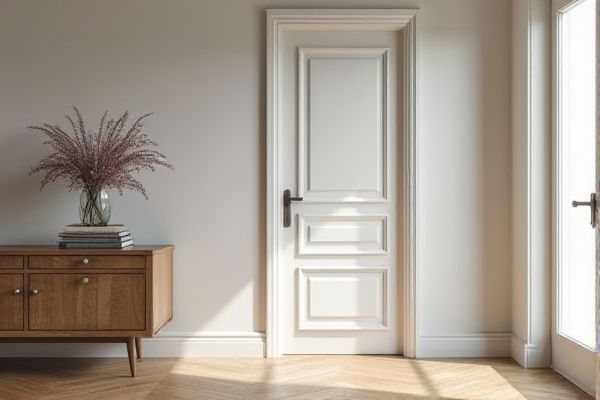
Panel doors feature framed sections with raised or recessed panels offering a classic, decorative look, while flush doors have a smooth, flat surface providing a modern, minimalist aesthetic. Discover the key differences, advantages, and ideal uses of each type to help you choose the perfect door for your space.
Table of Comparison
| Feature | Panel Door | Flush Door |
|---|---|---|
| Construction | Frames with panels (wood, glass, or metal) | Flat surface, hollow or solid core |
| Design | Decorative, classic look | Minimalist, modern appearance |
| Durability | High, due to frame and panel strength | Moderate, depends on core material |
| Maintenance | Easier to repair individual panels | Simple to clean, but difficult to repair |
| Insulation | Better sound and thermal insulation | Depends on core type; hollow less efficient |
| Cost | Generally higher due to complex design | Usually lower, cost-effective option |
| Application | Traditional homes, decorative interiors | Modern homes, commercial spaces |
Introduction to Panel Doors and Flush Doors
Panel doors feature a framework of rails and stiles with recessed or raised panels, offering classic aesthetics and structural stability often used in exterior and interior applications. Flush doors consist of a solid or hollow core covered with a smooth veneer or laminate surface, providing a sleek, modern look with easy maintenance and cost-effectiveness. Both door types vary in materials, sound insulation, and design versatility, making them suitable for different architectural styles and functional needs.
Key Differences Between Panel Doors and Flush Doors
Panel doors feature multiple framed sections with raised or recessed panels, providing classic aesthetics and enhanced structural strength, while flush doors have a smooth, flat surface offering a modern, minimalist look and are typically lighter. Panel doors use solid wood or engineered wood components, making them more durable and resistant to warping, whereas flush doors often consist of plywood or MDF with a hollow or solid core, influencing sound insulation and durability. Your choice depends on desired style, durability requirements, and budget, as panel doors suit traditional and sturdy applications, while flush doors excel in contemporary, cost-effective interiors.
Design and Aesthetic Comparison
Panel doors feature raised or recessed sections that create a classic, textured appearance suitable for traditional and rustic interiors, while flush doors offer a smooth, flat surface that complements modern and minimalist design styles. The intricate detailing of panel doors adds depth and visual interest, whereas flush doors provide a sleek, unobtrusive look that can easily blend with various decor themes. Your choice depends on the desired aesthetic impact, whether you prefer decorative charm or clean simplicity.
Material Options for Panel and Flush Doors
Panel doors commonly utilize hardwoods like oak, mahogany, and pine, offering durability and classic aesthetics, while flush doors are typically constructed from engineered wood products such as plywood, MDF, or particleboard, providing cost-effectiveness and smooth surfaces. Panel doors feature raised or recessed panels, allowing for intricate designs and the use of varied materials like glass inserts or metal accents. Flush doors emphasize a flat, uniform finish, often enhanced with veneers or laminates to mimic natural wood grains or provide contemporary looks.
Durability and Maintenance
Panel doors, constructed with multiple layers and frames, offer superior durability by effectively resisting warping and cracking, making them ideal for high-traffic areas. Flush doors feature a smooth, flat surface with a solid or hollow core, requiring less maintenance due to their simple design and ease of cleaning. Both door types benefit from proper sealing and finishing, but panel doors may demand more upkeep to maintain their intricate details and prevent moisture damage.
Cost Analysis: Panel Door vs Flush Door
Panel doors typically cost more than flush doors due to their intricate design, requiring additional materials and labor for crafting the raised or recessed panels. Flush doors are generally more affordable, featuring a smooth, flat surface made from plywood or MDF, making them cost-effective for budget-conscious projects. Your choice depends on balancing aesthetic preferences with budget constraints, as panel doors offer classic appeal while flush doors provide economical simplicity.
Installation Process Differences
Panel doors require precise fitting of individual stiles and rails within a frame, often involving mortise and tenon joints, which makes installation more labor-intensive and time-consuming. Flush doors consist of a smooth, flat surface with a hollow or solid core, allowing for quicker installation using standard hinges and minimal alignment adjustments. The structural complexity of panel doors demands skilled craftsmanship, whereas flush doors offer streamlined installation suited for modern construction projects.
Insulation and Soundproofing
Panel doors provide better insulation and soundproofing due to their multi-layered construction with recessed panels that trap air, which acts as a natural insulator. Flush doors have a smooth, flat surface typically made from plywood or MDF over a solid or hollow core, offering less sound dampening compared to panel doors. The air pockets and thickness in panel doors significantly reduce noise transmission, making them ideal for rooms requiring enhanced privacy and thermal efficiency.
Best Applications and Uses
Panel doors are ideal for classic interior designs and exterior applications requiring enhanced durability and decorative appeal, commonly used in traditional homes, offices, and entryways. Flush doors suit modern minimalist aesthetics and interior spaces where smooth, clean surfaces are preferred, making them perfect for bedrooms, bathrooms, and commercial buildings. Both door types offer distinct advantages in sound insulation and security, with panel doors often favored for heavy usage and flush doors chosen for cost-effective versatility.
Choosing the Right Door for Your Space
Panel doors offer classic aesthetics and enhanced durability with their frame and panel construction, making them ideal for traditional and high-traffic areas. Flush doors provide a sleek, minimalist look with smooth surfaces, perfect for modern interiors and cost-effective solutions. Consider factors such as design preference, noise insulation, and maintenance requirements when choosing the right door for your space.
 homyna.com
homyna.com